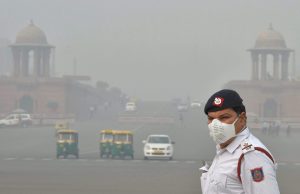 I travelled from Jaisalmer to Delhi, had a stopover at my house in Ghaziabad for four hours and then took a flight to Hyderabad on October 26, 2018. Within the transition from railway station to my house to the airport, I could feel the smoke in the air and it was so bad that even those few hours in Delhi were tough to survive. There was a bad smell in the atmosphere and one could feel it even indoors. Since past many years, Delhi has become a gas chamber during winters. The reasons for it are many. Its three main contributors are:
I travelled from Jaisalmer to Delhi, had a stopover at my house in Ghaziabad for four hours and then took a flight to Hyderabad on October 26, 2018. Within the transition from railway station to my house to the airport, I could feel the smoke in the air and it was so bad that even those few hours in Delhi were tough to survive. There was a bad smell in the atmosphere and one could feel it even indoors. Since past many years, Delhi has become a gas chamber during winters. The reasons for it are many. Its three main contributors are:
Crop burning in Punjab, Haryana and UP:
The rice crop residue is being burnt because it has no other usage. For instance in Bihar, the rice crop residue is a food for the cattle but the crop residue in Punjab and Haryana is full of so much pesticide and fertilisers that it cannot be used as fodder. So, they are left with no option other than burning it off. Pracheer Dutta, incubated in IIT Delhi has come up with a solution to it. He has developed a technology by which crop residue or agro waste can be converted into pulp which is used to make value-added products like disposable tableware. So, he is putting an effort to utilise the crop residue of Punjab and Haryana and make disposable plates from it. So, what is being burnt today causing so many harmful effects could be an additional source of income for the farmers and would also replace plastic.
Vehicular pollution in Delhi NCR:
Delhi has the highest number of vehicles in the country with a total of 7.6 million vehicular population as per the Delhi government. These vehicles emit lot of harmful gases thus heating up the atmosphere. The wind pressure during winters is high in surrounding areas of Delhi while it is low inside Delhi due to heavy vehicular pollution, thus all the dust from surrounding areas is attracted towards Delhi.
The wind from the Thar Desert in Rajasthan brings lot of fine sand particles thus thickening Delhi’s air and creating smog. All these factors along with slow wind speed create a smog and heavy pollution in the national capital. According to Central Pollution Control Board (CPCB), the overall Air Quality Index (AQI) of Delhi is 401, falling in the ‘severe’ category. An AQI between 0 and 50 is considered ‘good’, 51 and 100 ‘satisfactory’, 101 and 200 ‘moderate’, 201 and 300 ‘poor’, 301 and 400 ‘very poor’, and 401 and 500 ‘severe’. Eighteen areas of Delhi recorded “severe” air quality with the highest AQI recorded at Anand Vihar at 467, according to data by the CPCB. Faridabad, Ghaziabad, Gurgaon and Noida recorded ‘severe’ air pollution, crossing the AQI of 400.
SOLUTIONS
Much focus has been laid on the problems. Here are some of the long term measures which we need to adapt if we want to live in the city. Else, we all will be forced to migrate out of Delhi. My home is in Delhi but I am writing this piece sitting in Patna because I don’t want to develop diseases by smelling the polluted air of the capital. I have the money and luxury to stay away but majority don’t. So, both the government and the citizens have to come together to find some long-term solutions. Here are few of them.
No more trees specially those which are 40 to 200 years old should be allowed to be cut in the name of development. Trees play the most important role in controlling pollution and providing fresh air. The NBCC and CPWD projects of central government plan to cut more than 20,000 fully grown trees in South Delhi. Aravali Biodiversity park having rich wildlife and birds is in danger because of road construction by NHAI. Trees are being cut in several other corners of NCR in the name of construction and progress. But, enough damage has been done to the city. Delhi needs at least 33 per cent forest cover as per National Forest Policy but it possesses only 20 per cent green coverage. We are already short of 13 per cent green coverage and still the government plans to cut more trees. The govt and the citizens must do as much plantation as possible and the work doesn’t end here. We need to take care of the sapling till at least one year of its growth so that it survives.
Measures should be taken to reduce further concretisation of the city. Even if there is a plan to do new construction, green building norms should be followed. This can at least be implemented on all government constructions to start with. A minimum percentage of green area should be maintained in every building.
Public transport must be made more frequent. The number of public buses specially the electric buses should be increased. People should be motivated to use public transport by reducing metro and bus fare and giving other attractions.
Heavy taxes should be imposed on buying of new private cars to reduce the number of vehicles on the road.
Blanket ban on new diesel vehicles. 10 to 15 year old diesel vehicles should also be brought off the roads.
There should be incentive towards car pooling and shared cabs both by private companies and the government.
Do not burn the landfills instead develop a proper waste segregation and management system from its source.
Alternative technologies for crop burning like turning crop residue into disposable tableware should be encouraged and promoted by the govt.
Above are some imperative long-term measures that govt must take to prevent Delhi’s air from getting spoiled further.
Here are some temporary relief measures that an individual can take to protect themselves from pollution.
Since most people in Delhi NCR live in apartments, they can have terrace or balcony garden. Also growing indoor plants like Areca Palm, Lady Palm, Bamboo palm, Rubber Plant can help in naturally purifying the air.
People should try avoiding the use of private transport to reduce emission of pollutants.
Try and stay indoors as much as possible.
Please do not burn any crackers on Diwali, weddings or any other occasion. Fitness of your lungs is more important than a fraction of excitement that that you get after watching the crackers.
Do exercise everyday early in the morning or late evening as exercise keeps the lungs healthy.
One can buy Air Purifiers as a temporary relief but personally I am not very much in favour of air purifiers as it may clean the air inside but it pollutes the outside air further more.
Those having asthma or other lung problems must keep their medicine handy.
Tomatoes, apples, broccoli, spinach, flaxseed are some of the food items that will help in reducing the impact of pollutants on your body. So, consume them often.
Wear masks when ever you move out of the house and carry it always with you.
As a citizen of the country and resident of Delhi NCR, I would plea Centre, Delhi, Punjab and Haryana govt to stop playing blame game. An Harvard study suggests that crop burning is causing 50 per cent of the pollution in Delhi but there is no denial in the fact that vehicular pollution and lot of other factors within Delhi is responsible for this dreary situation. Global warming and climate change primarily due to cutting of trees and many other factors are also the root cause. We have to identify the root cause and take precautionary measures so that the situation doesn’t worsen further. Having fought against the NBCC and CPWD massive tree cutting projects in Delhi, its my strong belief that the existing trees which are over 50 and 100 years old are the only natural protectors we are left with that is saving us from this environmental disaster. So, please do not touch any tree be it in South Delhi, Aravali’s or Greater Noida and instead the focus should be on planting and nurturing lakhs of more trees to create a warrior against the pollution. As, the concrete buildings or the roads that are being built will never help in fighting the pollutants rather it will increase it more.
Prerna Prasad is an environmental activist and founder of Ecoplore (Eco-friendly travel company)
letters@tehelka.com












